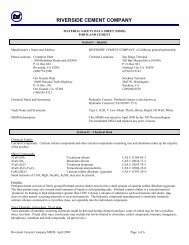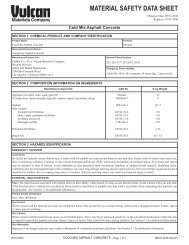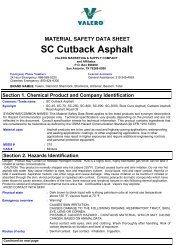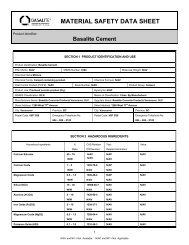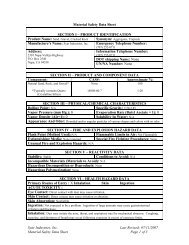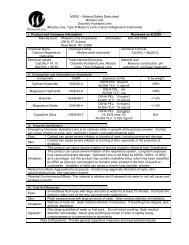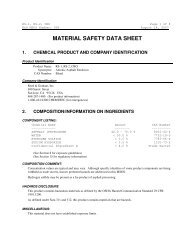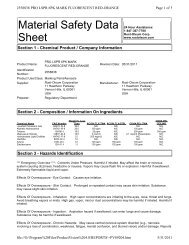MSDS 3239-011-WT (Asphaltic Concrete) - CALVAC Paving
MSDS 3239-011-WT (Asphaltic Concrete) - CALVAC Paving
MSDS 3239-011-WT (Asphaltic Concrete) - CALVAC Paving
Create successful ePaper yourself
Turn your PDF publications into a flip-book with our unique Google optimized e-Paper software.
Carcinogenicity:Skin application of asphalt fume condensate fractions caused skin tumors in laboratory mice. When asphalt was dissolved or mixed with a solventprior to exposing laboratory animals, the carcinogenicity results were weakly positive. The causal agent is thought to be 4 to 6 ring polycyclicaromatic compounds (PAH). Trace amounts of these materials may be present in asphalts and can be generated upon excessive heating. Some PAHshave been identified as causing carcinogenic and reproductive effects. Currently, epidemiological evidence does not support a link between asphaltexposure and human skin cancer.Repeated breathing of asphalt emissions has not resulted in a carcinogenic response in laboratory animal testing. Although epidemiological studieson asphalt workers have suggested a possible link between asphalt fumes and certain types of cancer, confounding factors such as smoking andconcomitant exposure to other agents in the workplace may have influenced the results of these studies. Asphalt is not listed as a carcinogen by theNational Toxicology Program (NTP) or the Occupational Safety and Health Administration (OSHA). In 1985, the International Agency for Researchon Cancer (IARC) determined that there is inadequate evidence that asphalt alone is carcinogenic to humans. However, IARC states that there issufficient evidence that extracts (asphalts dissolved in hydrocarbon solvents) are carcinogenic to laboratory animals. Although epidemiologicalstudies on some petroleum products containing polycyclic aromatics suggest the possibility of skin cancer induction in humans, a link betweenpetroleum asphalt exposure and human skin cancer has not been established.This material contains heavy vacuum distillates/aromatic extract oils. IARC has determined that there is sufficient evidence in experimental animalsfor their carcinogenicity, and has classified these oils as Group 1, or human carcinogens.The following information applies to the dried product if it is subjected to mechanical forces (such as demolition or asphalt recycling work),which may generate crystalline silica-containing dust particles:Epidemiology studies on the association between crystalline silica exposure and lung cancer have had both positive and negative results. There issome speculation that the source and type of crystalline silica may play a role. Studies of persons with silicosis indicate an increased risk ofdeveloping lung cancer, a risk that increases with the level and duration of exposure. It is not clear whether or not lung cancer develops in nonsilicoticpatients. Several studies of silicotics do not account for lung cancer confounders, especially smoking, which have been shown to increasethe risk of developing lung disorders, including emphysema and lung cancer.In October 1996, an IARC Working Group designated respirable crystalline silica as carcinogenic (Group 1). The NTP's Report on Carcinogens, 9thedition, lists respirable crystalline silica as a “known human carcinogen.” In the year 2000, the American Conference of Governmental IndustrialHygienists (ACGIH) listed respirable crystalline silica (quartz) as a suspected human carcinogen (A-2). These classifications are based on sufficientevidence of carcinogenicity in certain experimental animals and on selected epidemiological studies of workers exposed to crystalline silica.SECTION 12. ECOLOGICAL INFORMATIONAquatic Ecotoxicological Data:No specific data on this product. The asphalt component may cause damage to aquatic organisms.Environmental Fate Data:Significant migration into the environment and bioaccumulation are unlikely. Expected to be resistant to biodegradation.Other:No specific data on this product.SECTION 13. DISPOSAL CONSIDERATIONSPlace contaminated materials in appropriate containers and dispose of in a manner consistent with applicable federal, state, and local regulations.Prevent from entering drainage, sewer systems, and unintended bodies of water. It is the responsibility of the user to determine, at the time ofdisposal, whether product meets criteria for hazardous waste. Product uses, transformations, mixture and processes, may render the resulting materialhazardous.SECTION 14. TRANSPORT INFORMATION [Note: Not intended to be all-inclusive.]DOT Proper Shipping Name:Not regulated.UN/NA Number:Not regulated.DOT Hazard Classification:Not applicable.DOT Packing Group:Not applicable.Labeling Requirements:If the shipping temperature of a solid equals or exceeds 464˚F, DOT regulation classifies the solid as an “Elevated Temperature Material”, and a “HOT”label is required. Label as required by the OSHA Hazard Communication standard [29 CFR 1910.1200(f)], and applicable state and local regulations.SECTION 15. REGULATORY INFORMATION [Note: Not intended to be all-inclusive.]Toxic Substances Control Act (TSCA):The components in this product are listed on the TSCA Inventory or are exempt.Comprehensive Environmental Response, Compensation and Liability Act (CERCLA):Releases of this material to water may be reportable to the National Response Center under the Comprehensive Environmental Response,Compensation, and Liability Act (CERCLA) or to state and local emergency planning committees under the Superfund Amendments andReauthorization Act. It is recommended that you contact state and local authorities to determine if there are any local reporting requirements in theevent of a spill.<strong>MSDS</strong> <strong>3239</strong>-<strong>011</strong>-<strong>WT</strong> ASPHALTIC CONCRETE - Page 6 of 7 05/31/2009
Superfund Amendments and Reauthorization Act of 1986 (SARA), Title III:Section 302 extremely hazardous substances:NoneSection 311/312 hazard categories:Immediate HealthDelayed HealthSection 313 reportable ingredients at or above de minimus concentrations:NoneCalifornia Proposition 65:WARNING: THIS PRODUCT CONTAINS CHEMICALS (CRYSTALLINE SILICA, BITUMENS, VARIOUS AROMATIC HYDROCARBONS)KNOWN TO THE STATE OF CALIFORNIA TO CAUSE CANCER AND BIRTH DEFECTS OR OTHER REPRODUCTIVE HARM.State Regulatory Lists:Each state may promulgate standards more stringent than the federal government. This section cannot encompass an inclusive list orall state regulations. Therefore, the user should review the components listed in Section 2 and consult state or local authorities forspecific regulations that apply.SECTION 16. OTHER INFORMATIONDisclaimer of LiabilityVulcan Materials Company believes the information contained herein is accurate, however, Vulcan Materials Company makes no guarantees withrespect to such accuracy and assumes no liability in connection with the use of the information contained herein by any party. The provision ofthe information contained herein is not intended to be and should not be construed as legal advice or as ensuring compliance with and federal,state, or local laws and regulations. Any party using this product should review all such laws, rules or regulations prior to use.NO WARRANTY IS MADE, EXPRESS OR IMPLIED, OF MERCHANTABILITY, FITNESS FOR A PARTICULARPURPOSE OR OTHERWISE.05/31/2009 ASPHALTIC CONCRETE - Page 7 of 7 <strong>MSDS</strong> <strong>3239</strong>-<strong>011</strong>-<strong>WT</strong>
CalMat Co., d.b.a. Vulcan Materials Company,Western DivisionSafety and Health Department3200 San Fernando RoadLos Angeles, CA 90065-1415<strong>MSDS</strong> <strong>3239</strong>-<strong>011</strong>-<strong>WT</strong>Dear Customer/Contractor:Please find attached a material safety data sheet (<strong>MSDS</strong>) for the product that youpurchased from Vulcan Materials Company. This is a revised <strong>MSDS</strong> and replacesany previous versions of the <strong>MSDS</strong> for this product. This <strong>MSDS</strong> is provided to youas required by the Occupational Safety and Health Administration's (OSHA)Hazard Communication Standard (29 CFR 1910.1200), the Mine Safety andHealth Administration's (MSHA) Hazard Communication Standard (30 CFR Part47), and/or any applicable state Right-to-Know laws.It is the responsibility of your company to communicate this information to youremployees, customers, and contractors who may use or come in contact with thisproduct. Further, if you distribute this product, Vulcan Materials Companyrequests, and applicable laws may require, that you forward this <strong>MSDS</strong> to yourcustomers.Please direct this information to the person responsible for safety and healthcompliance at your company. If you have questions about the <strong>MSDS</strong>, pleasecontact Vulcan Materials Company at the address and phone number listed onpage one of the <strong>MSDS</strong>.If you need additional copies of this or any other Vulcan Materials Company<strong>MSDS</strong> or a Spanish language version, you can obtain them atwww.vulcanmaterials.com or by calling 1-866-401-5424.La <strong>MSDS</strong> puede obtenerse en www.vulcanmaterials.com o llamando al 1-866-401-5424.Sincerely,Kelly F. Bailey, C.I.H.Corporate Director,Industrial Hygiene and Health ServicesP.O. BOX 385014 • BIRMINGHAM, ALABAMA 35238-5014



